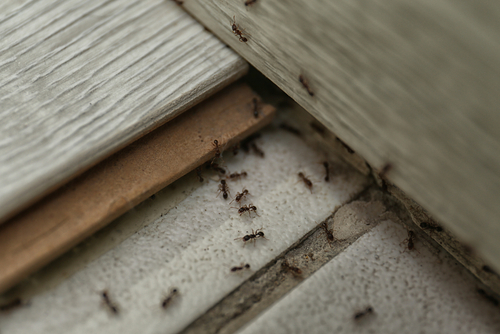How Weather Affects Insect Activity

Weather plays a significant role in the life cycles and behaviors of insects. From temperature and humidity to rainfall patterns and seasonal changes, various weather factors can greatly influence insect activity and population dynamics. Understanding how weather affects insect infestations can help homeowners and pest control professionals prepare for and effectively manage potential pest problems. In this article, we will explore the different ways weather can impact insect activity and discuss some preventive measures to keep infestations at bay.
1. Temperature and Insect Development
Temperature is a crucial factor in insect development and reproduction. Most insects have specific temperature ranges within which they thrive and reproduce. Warmer temperatures generally accelerate the growth and development of insects, leading to increased population sizes and quicker reproduction cycles. In colder temperatures, insect development slows down, and the number of viable eggs and larvae diminishes. Therefore, a warmer climate often results in higher insect activity levels and more significant infestations.
2. Humidity and Insect Survival
Humidity levels also play a vital role in insect survival. Some insects, such as cockroaches and termites, thrive in environments with high humidity levels. Excess moisture in the air and damp conditions provide them with the necessary conditions for survival, reproduction, and increased infestation rates. On the other hand, arid or dry climates can limit the survival and reproduction capabilities of certain insects, potentially reducing infestation risks.
3. Rainfall and Insect Breeding
Rainfall patterns can significantly impact insect breeding and population dynamics. Heavy rainfall can create ideal breeding conditions for mosquitoes, as they require stagnant water to lay their eggs. Excessive rain can lead to the accumulation of water in tires, gutters, flowerpots, and other areas, providing a perfect breeding ground for these disease-carrying pests. Similarly, beneficial insects like honeybees may experience disruptions in their foraging and pollination activities during extended periods of rainfall, affecting crop production and ecosystem stability.
4. Seasonal Changes and Insect Life Cycles
The changing seasons can influence the life cycles and behaviors of many insect species. For example, during the spring, when temperatures rise and days become longer, certain insects may emerge from dormancy and start their reproductive cycles. This can lead to heightened insect activity and infestations in residential areas. On the other hand, in colder winter months, some insects enter a state of diapause, a period of developmental arrest or hibernation, reducing their activity levels and keeping infestation risks relatively low.
Preventive Measures to Minimize Insect Infestations:
Knowing how weather impacts insect activity can help homeowners take appropriate measures to prevent infestations. Here are some preventive steps to minimize the risk of insect infestations:
1. Seal Entry Points:
Inspect your home for any cracks, gaps, or openings that insects could use as entry points. Ensure that windows and doors are properly sealed and install weatherstripping if necessary. Seal any gaps around utility lines, vents, and pipes with caulk or appropriate materials to prevent pest intrusion.
2. Eliminate Moisture:
Reduce excess moisture in and around your home by addressing any plumbing leaks, fixing leaky roofs, and ensuring proper drainage. Use dehumidifiers in damp areas, such as basements, to maintain optimal humidity levels and dry out potential breeding grounds for pests.
3. Maintain Cleanliness:
Keep your home and surrounding areas clean and free of food debris. Regularly vacuum, mop, and wipe down surfaces to eliminate crumbs and spills that can attract insects. Dispose of garbage in tightly sealed containers and clean up pet food and water dishes promptly.
4. Take Care of Outdoor Areas:
Trim bushes and trees away from your home, as overgrown vegetation can provide shelter and breeding grounds for insects. Store firewood away from the house and elevate it off the ground to reduce termite risks. Regularly inspect outdoor furniture, play structures, and fences for signs of insect activity and treat as necessary.
5. Consult with Pest Control Professionals:
If you are experiencing persistent insect infestations, it may be beneficial to consult with a professional pest control company. They can conduct a thorough inspection of your property, identify potential problem areas, and provide effective pest treatment options tailored to your specific pest issues.
Summary
Weather conditions have a significant impact on insect activity and population dynamics. By understanding how temperature, humidity, rainfall, and seasonal changes affect insects, homeowners can take proactive measures to minimize infestation risks. Remember, prevention is key, and maintaining a clean, dry, and well-sealed home is crucial in keeping unwanted pests at bay.
Need Exterminators in Bartlesville, OK?
Family owned and operated since 2003, we have earned a reputation for providing quality, reliable, timely, and affordable pest control services to the residents and businesses of Oklahoma and Kansas. Our team of highly skilled, experienced, and certified staff uses only use the most technologically advanced treatment methods while respecting your home needs. We specialize in the removal of ants and carpenter ants, termites, cockroaches, fleas, spiders, bed bugs, stinging insects, mice, rats and more! We offer monthly, bi-monthly, quarterly, semi-annual and annual service for your convenience and peace of mind! Contact us today to learn more about what we can do for you!
